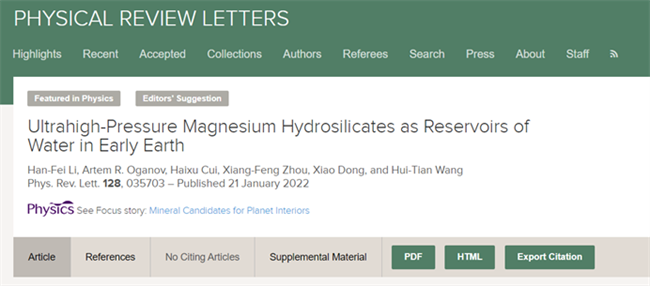Researchers of Nankai University provide new insights into the origin of water on Earth
The age-old mystery of "Where the Earth's water comes from" is crucial to understanding how life emerged and how the dynamics of the Earth's interior have evolved over time.

Dr. Li Hanfei, associate professor Dong Xiao and their collaborators from the School of Physics, Nankai University, have provided a new approach to this important scientific problem. The paper "Ultrahigh-Pressure Magnesium Hydrosilicates as Reservoirs of Water in Early Earth" was published in Physical Review Letters, a top journal in physics, on 21 January and was listed in Editor's Suggestion. The Physics, a journal for reporting physics results, has featured an article on it.
Engaged in the research of hydrate design and physical property prediction under extreme conditions for a long time, associate professor Dong Xiao found that two new hydrated magnesium silicate phases are stable at millions of atmospheres through first-principle calculation and structure prediction method. Among them, α-Mg2SiO5H2 is stable at 262 -- 338 GPa, and β-Mg2SiO5H2 is stable above 338 GPa (compared to the pressures 136 GPa at the current core-mantle boundary and 360 GPa at the center of the Earth). The structural difference between the two is that β-Mg2SiO5H2 possesses the magnesium ion in 9 coordination form for the first prediction. Further study shows that both of them are in the superionic conductor form of quasi-one-dimensional proton diffusion at high temperatures.

Two Mg2SiO5H2 structures

Early Earth evolution involving hydrosilicate
Calculations show that under ideal conditions the Earth’s interior in the early period could store water eight times the mass of the ocean nowadays in the form of Mg2SiO5H2. Later, with the process of core-mantle separation, the irony core gradually grew up, which raised the silicate and reduced its pressure, thus forcing Mg2SiO5H2 to decompose and release water. The water released returned to the Earth's surface through complex geophysical and chemical processes, while at this time the Earth's surface had cooled enough to allow the existence of liquid water to form the proto-ocean. The decomposition products of Mg2SiO5H2, MgSiO3 and MgO, still played important roles in the lower mantle. Meanwhile, the discovery of Mg2SiO5H2 is also of great significance for us to know other Earth-like planets, especially matter circulation in super-Earth.
This work fills the gap of the material existence form of the hydrosilicate system under the pressure of hundreds of GPa, opens up a new perspective for water and light element circulation in the early Earth, and deepens the understanding of the material existence and circulation process in the separation process of core-mantle.
As one of the top journals in physics, the Physical Review Letters is a comprehensive journal of physics founded by the American Physical Society in 1958, mainly publishing important physical research results. the Physics, formerly known as the Physical Review Focus, is a scientific report journal founded by the American Physical Society, reporting the latest important achievements in scientific research and having great influence in the academic world.
The work has been supported by the National Natural Science Foundation of China, Tianjin Municipal Natural Science Foundation, National Supercomputing Center in GuangZhou, National Supercomputing Center in Nankai University, and other related funds.
Link to the paper: https://journals.aps.org/prl/abstract/10.1103/PhysRevLett.128.035703
Link to the Physics comment: https://physics.aps.org/articles/v15/9</450>
(Edited and translated by Nankai News Team)









